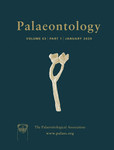Reg. Charity No. 1168330

Cetaceans constitute a textbook example of the secondary adaptation of tetrapods to aquatic life. This major event in the evolutionary history of mammals is often linked in the literature to the limb‐to‐fin transition. Paradoxically, limb bones are scarce in the fossil record of early cetaceans, and the transition from a limb‐adapted morphology for an amphibious life in shallow water to a fin‐adapted morphology for a pelagic lifestyle remains poorly documented. Here, we describe new protocetid remains from the upper Lutetian of Senegal, including a nearly complete articulated forelimb. A cladistic analysis including 24 taxa and 137 morphological characters recovers the new African specimen close to Carolinacetus. It also confirms that cetacean dispersal to the New World was not the result of a single colonization event. A 3D model of the forelimb was reconstructed. Anatomical comparisons suggest that it is unlikely that the Senegalese forelimb was used as a rigid pectoral flipper for steering as in basilosaurids and modern cetaceans. Instead, we suggest that the hand was actively used during swimming. This challenges previous reconstructions of protocetids as mainly foot‐powered swimmers, and suggests that swimming specializations of early cetaceans were probably more diverse than previously considered.